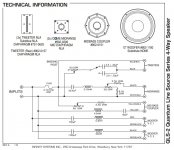And known points ... Question is, if you have an existing passive crossover with known point and slopes, why doesn't simply programming the matching active parameters work the same? Is it even a good starting point?
{assive is loaded by the loudspeakers' impedance, active is being loaded by the (pretty much flat) input impedances of the power amplifiers.
You can start there, my system is an active 3 way with 24dB octave LR which was not practical in the prior passive speaker level crossover. I made that decision before I even made the switch, eventually I replaced the purchased crossovers with ones of my own design. One possible option would be to implement your experimental crossovers in DSP and later if so inclined build analog crossovers based on what worked best in DSP.
Wait really? Even if you cant read all of the values? I would LOVE to do this.We can help you reverse engineer your passive..
A very inexpensive LCR meter (or component tester board) would eliminate that as an eventuality.Wait ... really?
Wait really? Even if you cant read all of the values? I would LOVE to do this.
There is more than one way to do it. One needs the values and the impedance plots. The other uses a swept measurement, eg using REW or Holmimpulse (no microphone needed).
In case you can make measurements of the individual driver+filters acoustic output (through the tracing function in e.g. Vituixcad) you could use those as the so called "target function" for your active design. Then you manipulate and optimize the active analogue circuit or the digital filter slopes (again in Vituixcad) until the driver filter combo matches the measured target slopes as per above. Being able to carefully measure in ARTA, REW, CLIO etc is mandatory.
Case in point: I have Infinity Quantum 2. 4 Way. Previous owner tried to 'improve' (convert to tri amp?). NOT working. Instead of trying to fix or rebuild, I consider building active crossover. Known: Crossover frequencies 200, 400, 6k. Watkins dual voice coil setup.
Attachments
I want to go active crossover (one reason being that I would have to rebuild the passive crossover pretty much from scratch), and at the minimum bi amp (the Watkins setup for the woofer really puts some demand on the amp; freeing up that stress from the amp (class A? Tube?) for the lowmid driver, mid cone tweeters and high ribbon should help.
Not sure I should open my mouth here as I have never designed a crossover from scratch and there are already replies from people who know 10^6x more on the subject than I do.
Still for the benefit of Flaxxer there is this fresh writeup by Troels Gravesen on the very subject
http://www.troelsgravesen.dk/passive-to-active.htmThere is also a very interesting thread by EUVL about the same subject which as far as I understand does not require measuring the response of the drivers (but it does assume that the passive crossover does good job and you like the sound of the speaker with that crossover. I does require measurements of the electrical response of the xover )
https://www.diyaudio.com/community/...ogue-active-crossover-filter-solution.329458/
Still for the benefit of Flaxxer there is this fresh writeup by Troels Gravesen on the very subject
http://www.troelsgravesen.dk/passive-to-active.htmThere is also a very interesting thread by EUVL about the same subject which as far as I understand does not require measuring the response of the drivers (but it does assume that the passive crossover does good job and you like the sound of the speaker with that crossover. I does require measurements of the electrical response of the xover )
https://www.diyaudio.com/community/...ogue-active-crossover-filter-solution.329458/
Troels makes out that it cannot be done without measurements but often it can. Maybe he hasn't worked through the problem that far yet.this fresh writeup by Troels Gravesen
Currently looking also into using a DSP (miniDSP 2x8 supposedly can do a 4 way stereo crossover). Just my past (say 4 decades ago), we build our 24dB active crossovers (3 way back then) with some op amps, resistors, capacitors and good clean power supplies. ONLY issue with 'analog active': to change anything, need to change components. The digital way, I assume can be done simply by changing an input on the computer. So LOTS of trial/error/play options.
Post 8 tells you all you need. We are not talking about modfication, we are talking about emulation a.k.a. cloning an existing passive filter. Troels is blurring matters unneccessarily.
All you need is the electric transfer functions of the passive filter that is loaded by the real drivers' impedances.
All you need is the electric transfer functions of the passive filter that is loaded by the real drivers' impedances.
Appologies. I kind of anticipated this reply.Troels makes out that it cannot be done without measurements but often it can. Maybe he hasn't worked through the problem that far yet.
I should have added this
https://www.diyaudio.com/community/...igning-crossovers-without-measurement.189847/for reference as well.
Oh, no I wasn't talking about creating a crossover where there wasn't one, I'm talking about the process of emulating an existing crossover.I kind of anticipated this reply.
I should have added this
- Home
- Loudspeakers
- Multi-Way
- Going active with known slopes?
